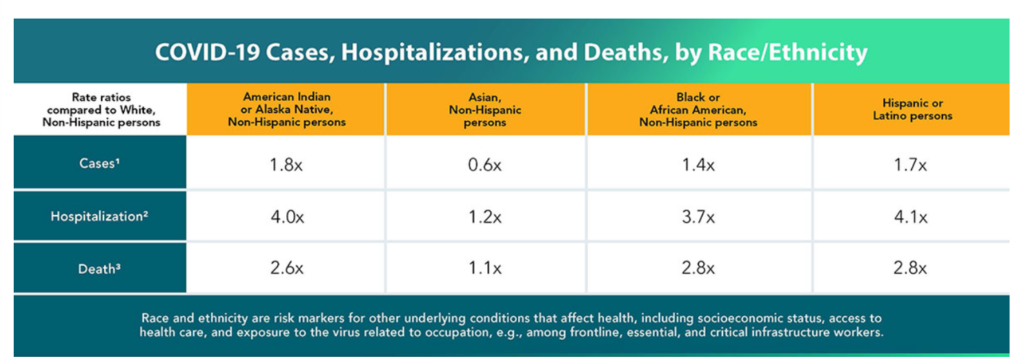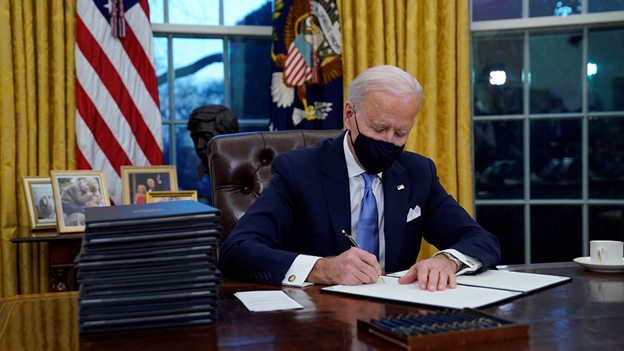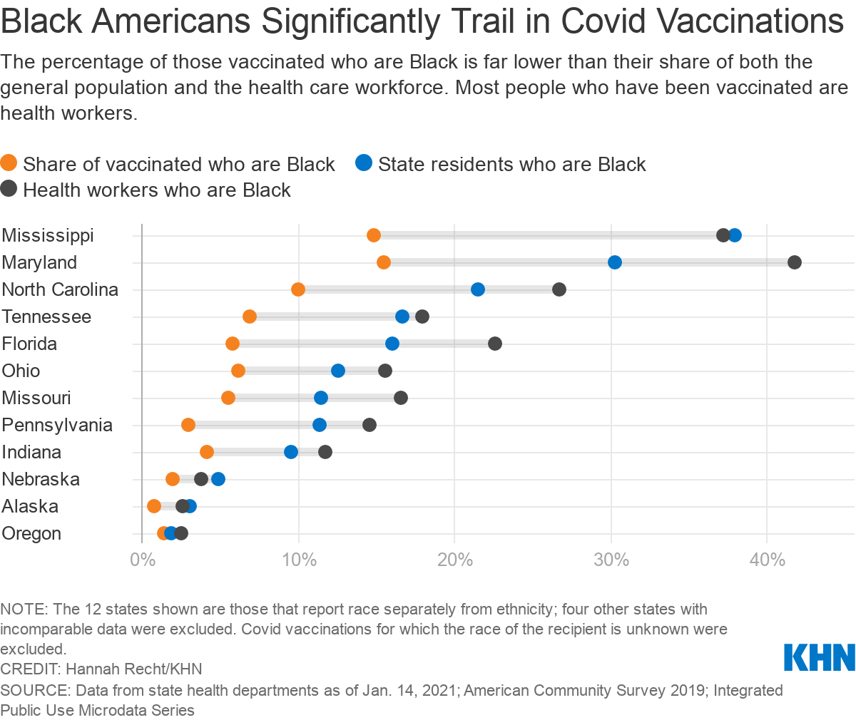In the U.S., the COVID-19 pandemic has revealed disparities in housing, food, and job security, and the role that one’s ZIP code and social determinants play in health outcomes.
 Overall, America has done poorly in light of being 4% of the world’s population but having one-fifth of the planet’s deaths due to the coronavirus.
Overall, America has done poorly in light of being 4% of the world’s population but having one-fifth of the planet’s deaths due to the coronavirus.
But these have disproportionately hit non-white people, who are nearly three times as likely to die from COVID-19 than white Americans.
I’ve been head-down reviewing the first two days of President Biden’s signing Executive Orders, reading the National Strategy for COVID-19 Response, and inventorying line items in the American Rescue Plan (aka, the Biden Stimulus Plan), it’s clear that this administration is baking “equity” in their vision of what success will look like for the 46th Presidency.
Here’s a key detail in the fine print of the Executive Order on Advancing Racial Equity and Support for Underserved Communities Through the Federal Government:
“Equal opportunity is the bedrock of American democracy, and our diversity is one of our country’s greatest strengths. But for too many, the American Dream remains out of reach. Entrenched disparities in our laws and public policies, and in our public and private institutions, have often denied that equal opportunity to individuals and communities. Our country faces converging economic, health, and climate crises that have exposed and exacerbated inequities, while a historic movement for justice has highlighted the unbearable human costs of systemic racism,” the Order explains.
While this Executive Order specifically asks every Agency to review its policies for barriers to opportunities for all, and to address those obstacles in re-formulating policies, other Orders the President signed at his Resolute Desk this week on Days 1 and 2 since taking his place in the White House speak to equity, all of which will have import and impact on public and individual health.
 A few examples:
A few examples:
Executive Order on Protecting Public Health and the Environment and Restoring Science to Tackle the Climate Crisis: this Order points out, the need to, “improve public health and protect our environment…to hold polluters accountable, including those who disproportionately harm communities of color and low-income communities…and to prioritize both environmental justice and the creation of the well-paying union jobs necessary to deliver on these goals.”
Executive Order on Protecting Worker Health and Safety: The start of the Order calls out the fact that lower-income people and those of color have been essential workers during the pandemic. “Ensuring the health and safety of workers is a national priority and a moral imperative. Healthcare workers and other essential workers, many of whom are people of color and immigrants, have put their lives on the line during the coronavirus disease 2019 (COVID-19) pandemic. It is the policy of my Administration to protect the health and safety of workers from COVID-19.”
Executive Order on Preventing and Combating Discrimination on the Basis of Gender Identity or Sexual Orientation: The policy section of the Order asserts that, “All persons should receive equal treatment under the law, no matter their gender identity or sexual orientation. These principles are reflected in the Constitution, which promises equal protection of the laws. These principles are also enshrined in our Nation’s anti-discrimination laws, among them Title VII of the Civil Rights Act of 1964, as amended (42 U.S.C. 2000e et seq.).”
President Biden’s Executive Actions Deliver Economic Relief for American Families and Businesses Amid the COVID-19 Crises: Among the many line items in the stimulus bill and various Orders are tactics to address food insecurity and “the growing hunger crisis” for 29 million people in the U.S. (including 12 million children); better delivery of direct payments to people who haven’t received them in a timely manner; pausing federal collections on Veterans during the pandemic; assuring safe working conditions for people compelled to return to work in unsafe working conditions; and other programs to enable people to stay safe, financially viable, and healthy through the resolution of the public health crisis.
These are insights gleaned in just the first two days of the Biden Administration’s long work days in the White House. But I expect “equity,” broadly writ, will be embedded into all policies in and beyond health care over the next two years leading up to the mid-term elections in 2022 — from food to housing to workplace safety and, indeed, vaccination and treatment.
 Health Populi’s Hot Points: Last week, Kaiser Health News published an analysis on the gap between white Americans’ and black Americans’ rate of COVID-19 vaccination thus far in the stumbling vaccinating process.
Health Populi’s Hot Points: Last week, Kaiser Health News published an analysis on the gap between white Americans’ and black Americans’ rate of COVID-19 vaccination thus far in the stumbling vaccinating process.
This is but one current example of how health disparities are part of a larger constellation of systemic inequities in the U.S. economy and social fabric.
Note the gaps between the share of vaccinated people who are Black (in orange dots) compared with the percent of residents they represent in the states in which they live.
Even health workers who are Black have lagging vaccinations — and these people work in the front line of the COVID-19 pandemic.
This one data point represents the larger American national phenomenon of health and well-being being unequally distributed across health citizens.
Joe Biden’s approach to policy seeks to address the underlying causes of health disparities beyond health care….which benefits the entire economy, medical costs, and ultimately, public health.




 Thanks to Feedspot for naming this blog, Health Populi, as a
Thanks to Feedspot for naming this blog, Health Populi, as a